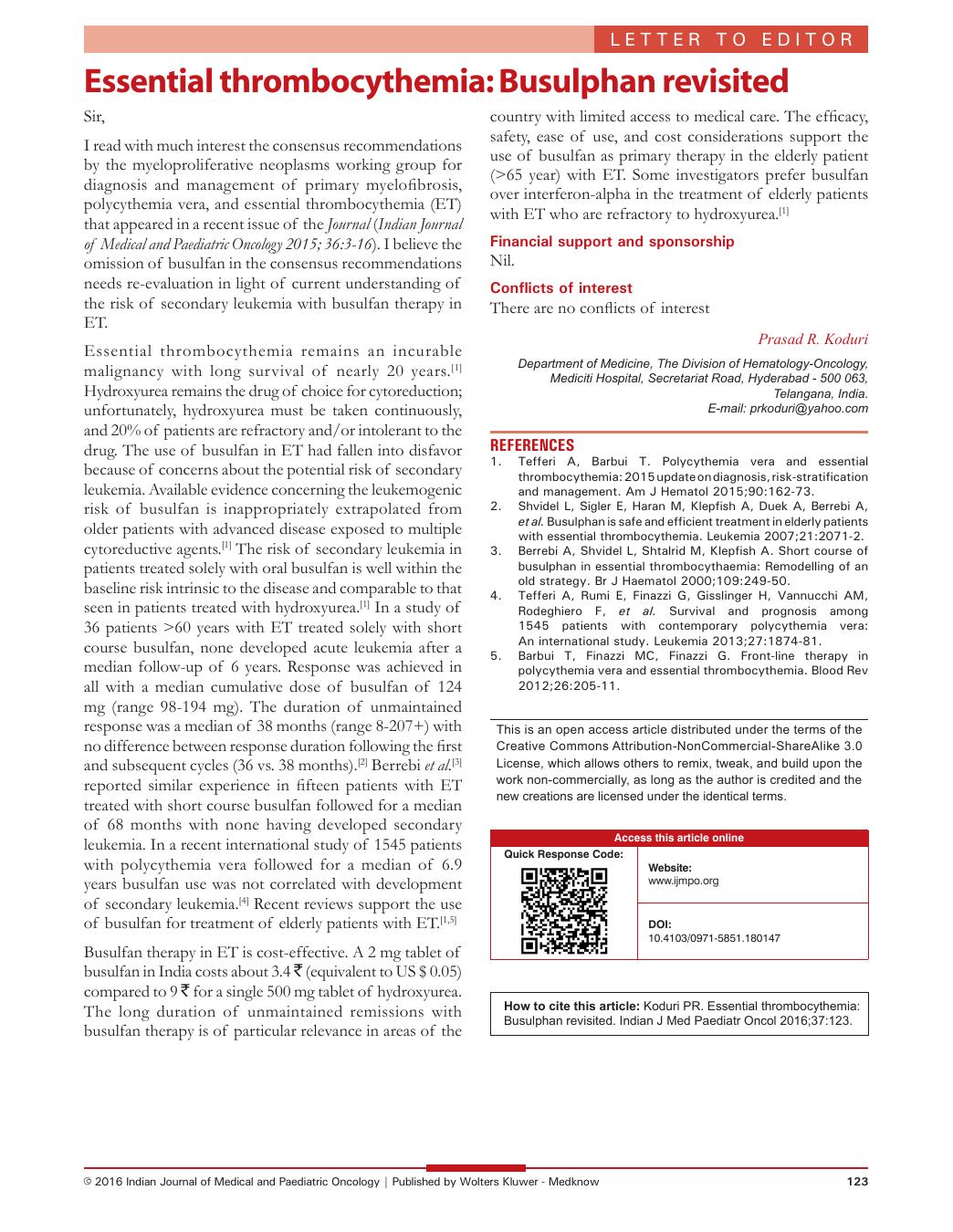Essential thrombocythemia: Busulphan revisited
CC BY-NC-ND 4.0 · Indian J Med Paediatr Oncol 2016; 37(02): 123
DOI: DOI: 10.4103/0971-5851.180147

Publication History
Article published online:
12 July 2021
© 2016. Indian Society of Medical and Paediatric Oncology. This is an open access article published by Thieme under the terms of the Creative Commons Attribution-NonDerivative-NonCommercial-License, permitting copying and reproduction so long as the original work is given appropriate credit. Contents may not be used for commercial purposes, or adapted, remixed, transformed or built upon. (https://creativecommons.org/licenses/by-nc-nd/4.0/.)
Thieme Medical and Scientific Publishers Pvt. Ltd.
A-12, 2nd Floor, Sector 2, Noida-201301 UP, India
Sir,
I read with much interest the consensus recommendations by the myeloproliferative neoplasms working group for diagnosis and management of primary myelofibrosis, polycythemia vera, and essential thrombocythemia (ET) that appeared in a recent issue of the Journal (Indian Journal of Medical and Paediatric Oncology 2015; 36:3-16). I believe the omission of busulfan in the consensus recommendations needs re-evaluation in light of current understanding of the risk of secondary leukemia with busulfan therapy in ET.
Essential thrombocythemia remains an incurable malignancy with long survival of nearly 20 years.[1] Hydroxyurea remains the drug of choice for cytoreduction; unfortunately, hydroxyurea must be taken continuously, and 20% of patients are refractory and/or intolerant to the drug. The use of busulfan in ET had fallen into disfavor because of concerns about the potential risk of secondary leukemia. Available evidence concerning the leukemogenic risk of busulfan is inappropriately extrapolated from older patients with advanced disease exposed to multiple cytoreductive agents.[1] The risk of secondary leukemia in patients treated solely with oral busulfan is well within the baseline risk intrinsic to the disease and comparable to that seen in patients treated with hydroxyurea.[1] In a study of 36 patients >60 years with ET treated solely with short course busulfan, none developed acute leukemia after a median follow-up of 6 years. Response was achieved in all with a median cumulative dose of busulfan of 124 mg (range 98-194 mg). The duration of unmaintained response was a median of 38 months (range 8-207+) with no difference between response duration following the first and subsequent cycles (36 vs. 38 months).[2] Berrebi et al.[3] reported similar experience in fifteen patients with ET treated with short course busulfan followed for a median of 68 months with none having developed secondary leukemia. In a recent international study of 1545 patients with polycythemia vera followed for a median of 6.9 years busulfan use was not correlated with development of secondary leukemia.[4] Recent reviews support the use of busulfan for treatment of elderly patients with ET.[1,5]
Busulfan therapy in ET is cost-effective. A 2 mg tablet of busulfan in India costs about 3.4  (equivalent to US $ 0.05) compared to 9
(equivalent to US $ 0.05) compared to 9  for a single 500 mg tablet of hydroxyurea. The long duration of unmaintained remissions with busulfan therapy is of particular relevance in areas of the country with limited access to medical care. The efficacy, safety, ease of use, and cost considerations support the use of busulfan as primary therapy in the elderly patient (>65 year) with ET. Some investigators prefer busulfan over interferon-alpha in the treatment of elderly patients with ET who are refractory to hydroxyurea.[1]
for a single 500 mg tablet of hydroxyurea. The long duration of unmaintained remissions with busulfan therapy is of particular relevance in areas of the country with limited access to medical care. The efficacy, safety, ease of use, and cost considerations support the use of busulfan as primary therapy in the elderly patient (>65 year) with ET. Some investigators prefer busulfan over interferon-alpha in the treatment of elderly patients with ET who are refractory to hydroxyurea.[1]
Nil.
Conflicts of interest
There are no conflicts of interest


 PDF
PDF  Views
Views  Share
Share

